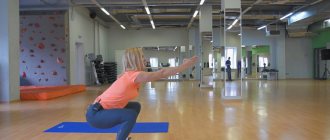It is unlikely that the American gynecologist Arnold Kegel counted on such widespread popularity of his method of strengthening intimate muscles, which he acquired among women all over the world. Nevertheless, the fact is clear.
Kegel exercises for women are widespread among the female population of the planet and are in high demand.
Kegel has developed a unique method of training two muscle groups: intimate and pelvic. For young women in the prenatal or postpartum period, such exercises are simply a salvation. They help keep muscles toned and elastic.
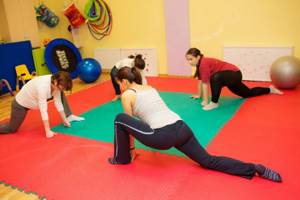
Over time, if you do not engage in such activities, these muscles can weaken. This is a bad process for women.
What are Kegel exercises?
These exercises were developed in the late 1940s by Arnold Kegel, an American gynecologist, as a non-surgical method to prevent urinary incontinence in women. This method is also effective for men suffering from this problem. The main function of these exercises is to strengthen the pelvic floor muscles, which surround and support the pelvis, like a hammock. The principle of operation of these exercises, of course, is completely no different from others - the muscle contracts and becomes stronger over time.
This means that in this case we need to squeeze the muscles of the pelvis - these are the same muscles that we squeeze in order to prevent urination, as well as those that we try to activate as much as possible in Pilates classes.
Indications for gymnastics for men and women
Preparing for pregnancy and childbirth. As you perform exercises, muscle tissue becomes more and more elastic, due to which it acquires the ability to stretch easily. This will help avoid divergence of internal muscles during pregnancy and ruptures during childbirth.
- Postpartum period. Kegel exercises are performed in order to restore the previous muscle tone.
- Prolapse of the pelvic organs. Since one of the causes of this problem lies in the weakening of the pelvic floor and internal muscles, strengthening them helps restore the normal position of the organs. Exercises can also be done for prevention. Unfortunately, if there is severe prolapse or, moreover, prolapse of organs has already occurred, gymnastics will not help.
- Urinary and fecal incontinence. It is completely curable with exercise unless it is caused by permanent injury. Initially, the Kegel complex was created to solve this problem.
- Haemorrhoids. Kegel exercises help only in its early stages and have proven themselves very well as a preventative measure. Hemorrhoids occur against the background of impaired blood circulation in the pelvis, and systematic muscle tension helps restore blood flow and lymph flow.
- Inflammatory diseases of the genitourinary system. Here exercises rather play a preventive role. Their action extends to sluggish chronic diseases. For example, if a woman periodically suffers from cystitis or inflammation of the appendages, gymnastics will help avoid exacerbations of the disease.
- Menstrual pain. Women notice that if they systematically perform intimate gymnastics, critical days are much easier to bear. Not only pain disappears, but also premenstrual syndrome.
- Anorgasmia. Exercises increase the sensitivity of the vaginal walls and reduce its volume.
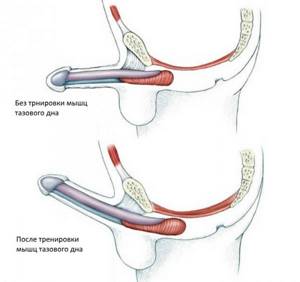
Many men regularly do Kegel exercises to strengthen their erections.
Despite the fact that the Kegel exercise system was originally created for the treatment and prevention of female diseases, over time it was adapted for men. Currently, these exercises are very popular among the male half of the population. They help restore sexual activity, strengthen erections and cope with prostatitis in the early stages.
Video: gynecologist's review of Kegel exercises and the use of a perineometer
What are the pelvic floor muscles?
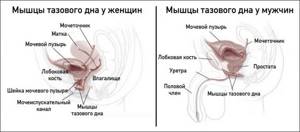
This is a group of muscles that support the bladder. They also help control the flow of urine. Here are the three main muscles of the pelvis:
- Bladder. It is a spherical muscle and holds urine.
- Sphincter muscles. They help open and close the urethra, the tube that drains urine from the bladder.
- Perineal muscles. They support the bladder and rectum and also help control the flow of urine.
Complex results
Particularly important for the fairer sex, the perineal muscles are toned, become obedient and controllable, elasticity increases, blood circulation, well-being and personal life improve.
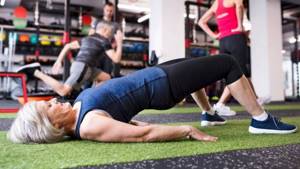
The complex mainly uses static methods of loading, which effectively influence groups of internal muscles, which are otherwise very difficult to use, even if a woman leads an active lifestyle.
How are such exercises useful?
We commonly hear about Kegel exercises being used for rehabilitation—especially in the context of postpartum vaginal strengthening. When women's perineal muscles weaken after giving birth, these exercises will help gradually strengthen them and begin the healing process.
Also, developing these muscles helps prevent symptoms of urinary incontinence. If you experience urinary incontinence when coughing, sneezing, laughing, bending forward, or lifting heavy objects (stress incontinence), it can be prevented by doing one or two Kegel exercises before doing the above. If you need to go to the toilet and aren't sure you can get there in time, these exercises can help. They, of course, will not be a panacea in such situations, but they will create a basis from which one can begin prevention and subsequent fight against the disease.
Execution conditions
When starting a Kegel training program, women at home should learn to tense the muscles of the perineum, and not the abdomen, buttocks or thighs.
During training, you should try to relax the remaining muscles so that overstrain and spasms do not occur.
While doing the exercises, you need to breathe calmly and not hold your breath. Proper breathing will help you perform better during the lesson. It helps you relax and feel your inner state.

Can Kegel exercises make orgasms more intense?
Of course they can. If we think about what exactly an orgasm is, we will see that it is a rhythmic contraction of the muscles of the perineum. Therefore, strengthening these muscles can potentially make orgasms more intense.
The orgasm-improving properties of these exercises make them especially recommended for menopausal women, as they may have problems achieving orgasm. Even if your orgasms are already powerful, regular perineal exercises will still benefit you - it will make them even stronger.
How to do Kegel exercises correctly?
- Find a muscle.
Unlike, for example, the biceps, the pelvic floor muscles are not so easy to find. The next time you go to the toilet, try to stop urinating. Feeling pressure? This is what they are. (Tip: This method is fine as a one-time method to determine the location of these muscles, but stopping urination often is not necessary - this can lead to bladder problems).
- The muscles should contract. In order to check whether you are doing the exercise correctly, gynecologists recommend the following method - you should place your finger in the vagina and tense the muscles - then you should feel a squeeze around the finger.
- Remember to maintain muscle tension without pulsation. Once you know how to do this, hold the tension between 3 and 10 seconds and then relax for 3 seconds. Imagine that you are holding a bead in your vagina - also imagine that you are pulling it in, rather than pushing it out.
- Make this part of your daily workout. Try to do 3 sets of 10 reps every day. Again, remember to do this regularly - it should be a daily activity, such as yoga or meditation. In order to notice significant positive changes, you need to do these exercises for six months.
Kegel exercises can also be done anywhere and anytime - if done correctly, they are completely invisible. From the outside, no one will be able to understand that you are doing them, because the gluteal muscles and hips should not contract.
- Try using special trackers. There are a large number of them, and they help determine the degree of development of the perineal muscles. Some even come with a special device that is inserted into the vagina and gives more accurate information. Some trackers measure muscle contraction strength, which you can use to measure your progress.
- Do not put anything into the vagina - devices and objects should be made of silicone, as it does not irritate. Also, wash them with soap and water every day after use.

Step-by-step instruction
First you need to find the muscles of the perineum, and then begin to strain them.
Kegel exercises will not improve your appearance; they are aimed at another, equally important function - strengthening the muscles that support the bladder.
Of course, Kegel exercises themselves are easy to do, but finding the right muscles to work them is not so easy. A third, if not more, of men and women who do Kegel exercises actually tighten their glutes, abdominal muscles, or inner thighs. Thus, they do not get the desired results from these exercises.
Here are some methods to detect your pelvic floor muscles.
For women:
- Imagine trying to avoid passing gas.
- Imagine trying to squeeze a tampon with your vagina.
For men:
- Imagine trying to avoid passing gas.
- While deurinating, try to stop urinating.
If you have found the right muscles, you should feel more tension in the back of your pelvic area than in the front.
Muscle tension
We choose a position. We start by lying on our back and try to squeeze the muscles of the perineum. If you can do it, try doing it sitting or standing.
Compression and release
- We squeeze the muscles of the perineum for 3 to 5 seconds.
- Relax for 3-5 seconds.
- Repeat this compression/relaxation cycle 10 times.
Keep other muscles relaxed. We do not strain the muscles of the abdomen, legs, or buttocks, or raise the pelvis. Gently place your hand on your abdomen to detect any unwanted muscle activity.
We give more time. Little by little we make the contractions and relaxations longer. We gradually reach 10-second contractions and relaxations.
Try to do more - at least 30 to 40 Kegel exercises per day. Instead of doing them all at once, it's better to spread them out throughout the day. Since they're completely invisible and no one but you knows you're doing them, you can do a few while you're waiting for a green light at a traffic light, riding an elevator, or waiting in line at a store.
Add variety. Do not only long, but also short compressions and relaxations, 2-3 seconds each.
Features of the exercises
There are recommendations to help you perform Kegel exercises correctly, depending on what diseases a woman has, and whether she has given birth or not.
Gymnastics for nulliparous girls
Some women think that intimate gymnastics is only for those who already have problems with the intimate muscles, or they may arise due to age or upcoming childbirth. This is a misconception. Girls who have not given birth and have no health problems can also perform Kegel exercises. This will help them prepare for conception and childbirth, as well as minimize the risk of developing diseases of the genitourinary system. They can perform the entire range of Kegel exercises, including the most difficult ones.
Video: results of intimate gymnastics
During pregnancy
Kegel exercises are very useful for pregnant women, but before performing it, just in case, you should consult a doctor.
During pregnancy, it is important to choose the right position for performing exercises. In the first trimester, while the fetus is small and the stomach remains flat, you can perform exercises while standing, sitting or lying down. In subsequent trimesters, lying down can create excessive pressure on the organs, so gymnastics is performed only in an upright position.
After childbirth
It is important that intimate gymnastics is not traumatic and does not cause discomfort. Therefore, you should not start exercising immediately after giving birth. The muscles need to recover. In addition, you need to wait until the bleeding stops. The optimal time to start classes is 2-3 weeks after the baby is born. You should start gymnastics with minimal load.
After caesarean section
The postoperative period (this applies not only to cesarean section, but also to any other abdominal surgery) is a contraindication to any physical activity. In addition, tension in the intimate muscles after surgery can lead to sutures coming apart. Therefore, you can start Kegel gymnastics only with the permission of a doctor. Typically, the rehabilitation period lasts about two months. Then you can begin to do simple exercises for the intimate muscles, and over time the emphasis will need to be placed on their deepest parts, since during the operation the smooth muscles of the uterus were primarily damaged.
When the uterus prolapses
Gymnastics helps in the initial stages. The subtleties of its implementation should be discussed with your doctor. He will evaluate the individual structural features of the female organs and determine whether there is a threat of pinching them. Kegel exercises in case of uterine prolapse should begin with tension in the anus, and only after a few sessions move on to the vaginal muscles. Exercises are performed only in a lying position. It will be possible to use other positions only when the doctor records positive changes.

When prolapse of the female organs occurs, it is recommended to supplement Kegel exercises by retracting the diaphragm
For urinary incontinence
Initially, Kegel exercises were developed specifically to combat this problem, and it is incontinence that is most easily treated with intimate gymnastics. Therefore, if it occurs, you should immediately begin intensive training. The first results will appear very quickly.
For hemorrhoids
The disease can progress in different ways, and Kegel exercises will not be effective in all cases. In some cases, on the contrary, they can cause harm, for example, when hemorrhoids prolapse. Therefore, intimate gymnastics is performed in the remission stage of the disease. At first, you should focus on the intimate muscles, eliminating tension in the anus.
After hysterectomy
Such a serious operation as hysterectomy is fraught with various consequences that are characteristic not only for the postoperative period. In particular, regular bleeding, persistent disturbance of urination and defecation, and pain may appear. In order to minimize the consequences of surgery, gynecologists recommend performing Kegel exercises. But you need to start them no earlier than 2 months after the operation. You need to start with light exercises, trying not to experience too much tension.
Video: gymnastics for intimate muscles, advice from a sexologist
During your period
Critical days are not a contraindication to performing Kegel exercises, but if your periods are painful, then muscle tension will only increase the discomfort, and at the same time bleeding. So during this period it is better to refrain from both intimate gymnastics and physical activity in general.
For muscle tone and vaginal tightening
Women who regularly perform exercises for intimate muscles note that the vagina narrows after just a couple of months of exercise. In this case, exercises should be performed intensively and in various poses. We must not forget about training the deep parts of the vagina, otherwise its diameter will decrease only at the level of the entrance, while there will still be excess space inside.
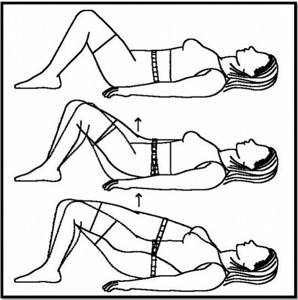
a good result is achieved by combining compression of the intimate muscles with raising the pelvis
To achieve orgasm
As the intimate muscles become stronger, their sensitivity increases, and the improvement in blood circulation that occurs due to training leads to the “reanimation” of nerve endings. Therefore, Kegel exercises may well solve the problem with orgasms. In addition, the vagina becomes narrower, which increases contact between partners. If the long-awaited orgasm still does not occur, you can try doing exercises directly during sex, choosing those that are most pleasant at this moment. Sometimes it is enough to simply squeeze the vagina and fix it in this state during intercourse.
The reasons for the lack of orgasm are not always related to physiology. Psychological problems and the wrong attitude towards sex also quite often interfere with full sensations during intimacy. In this case, Kegel exercises will not help solve the problem. Here, most likely, you will need the help of a psychologist.
Should everyone do these exercises?
Even if you don't have problems like incontinence, Kegel exercises are still recommended as part of your health care program.
But there are also some exceptions. If, for example, you have symptoms associated with tightness in the perineum, then it is better not to perform such exercises. In conditions such as vaginismus, such muscles should not be strained.
If you have serious problems with your perineum - if you have pain from conditions that cause tightness or weakness, and they do not get better after six months of these exercises, then you need to see a doctor for help.
Advanced training
The following exercises are a little more difficult; you can move on to them when the basic complex has already been mastered. It is important to do this gradually, without overexerting yourself, especially if you have any illnesses or during pregnancy.
Elevator . The exercise is based on slow compressions. Lying on the floor, bend your knees and gradually tense your intimate muscles from bottom to top. It's like you're gradually pulling something in. At each stage, stop for five seconds.
Ladder . This is a modification of the lift exercise. It is performed in the same way, but there is no five-second pause between compressions.
Flashing . Alternately tighten the vaginal muscles and anal sphincter. The abdominal and buttock muscles should remain relaxed.
Simultaneous tension . At the same time, squeeze the muscles of the vagina and anus as much as possible. Stay in this position for a minute and slowly relax.
Half bridge. Lie on the floor with your knees bent. Take a deep breath in through your mouth and out through your nose. As you exhale, slowly lift your pelvis while squeezing all your pelvic floor muscles. Stay in this position for five seconds. Do five sets.
Butterfly. Sit on the floor with your back straight. Bend your legs at the knees and bring your heels together as close to your perineum as possible. Take a few deep breaths in and out. As you exhale, squeeze your vaginal muscles. Hold the tension for a few seconds, then relax. Perform the exercise from five approaches.

It may be normal to have very slight muscle pain in the lower abdomen and in the tailbone area. This is similar to the pain of doing ab workouts. But if the pain doesn't feel like muscle pain or doesn't go away, see your doctor.
If you have just started exercising, your discharge patterns may change during your period. In the first two days, the blood will flow very profusely, and then decrease sharply. This is fine. Due to training, the epithelium is more actively rejected. Period pain may even decrease. But to the question whether it is possible to do Kegel exercises during menstruation, the answer will be negative. It's better to wait a few days.
Also watch lessons on Kegel exercises from a gynecologist:
Kegel exercises for men
If you think Kegel exercises are only for women, think again.
After all, they strengthen the very muscles that support the bladder and rectum, as well as those that affect sexual functions.
Before you begin these exercises, you need to find the right muscles and master the correct technique.
Benefits of Kegel exercises for men
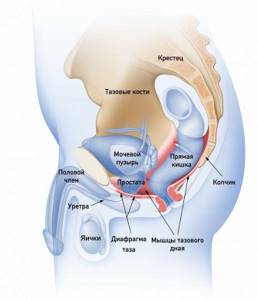
Many factors and causes can weaken the pelvic floor muscles. These include surgery to remove the prostate (radical prostatectomy), as well as certain diseases such as diabetes and bladder disease.
These exercises may help you if:
- You have urinary or fecal incontinence.
- You have urinary leakage after deurination—usually after you have already used the toilet.
Why do men exercise?
The prostate is a walnut-sized gland located under the bladder. It surrounds the upper part of the urethra. The urethra is the tube that carries urine through the penis to the outside. The prostate is surrounded by many muscles. These muscles can be weakened by prostate cancer treatment and this can cause urine leakage, i.e. incontinence. If you train and strengthen your perineal muscles, you will be able to better control your bladder and urine flow. Remember that this will take a lot of time, just like pumping up your arms or training a wide back or other muscle group in your body.
How to do Kegel exercises for men
Where to begin:
Find the right muscles. To locate your pelvic floor muscles, either stop urinating or tense the muscles you use to hold back bowel movements or intestinal gases. These maneuvers use the target muscles. Once you find these muscles, you can start doing the exercises in any position, but remember that it is best to start with the exercises lying down as they are easier.
Improve your technique. Tighten the muscles of the perineum, keep the muscles squeezed for three seconds, and then relax them for three seconds. Try doing this several times in a row. As your muscles become stronger, try doing Kegel exercises while sitting, standing, and while walking.
Concentrate. For best results, try to tense only the muscles of the perineum. Be careful not to tense your glutes, thighs, or abdominal muscles. Don't hold your breath. On the contrary, try to breathe freely during exercise.
Repeat 3 times a day. You need to do at least three sets of 10 repetitions per day.
When is the best time to train?
Make these exercises part of your lifestyle. For example:
Try doing a set of these exercises during a regular daily activity, such as brushing your teeth.
We do another approach after urination in order to get rid of the last drops of urine.
Squeeze the muscles of the perineum before and during any activity or process that strains the abdomen, such as sneezing, coughing, laughing or lifting heavy loads.
Now after you have found the necessary muscles, you can train them at any time, following the following instructions:
- Tighten your pelvic floor muscles and hold them there for 5 seconds.
- Now relax them. You have just completed one Kegel exercise. You should perform 10-20 repetitions three to four times a day.
Another way:
- Squeeze your anal muscles (as if you were trying to prevent a bowel movement).
- Relax your perineal muscles after each squeeze.
- Repeat this exercise 10-20 times.
When performing the exercise, remember the following:
Don't hold your breath.
Don't "push down." Squeeze your muscles tightly and imagine that you are trying to lift them up.
Don't tense your abdominal muscles, buttocks, or thighs.
Relax your perineal muscles between each squeeze.
Preparation for classes
Before starting independent training, you need to figure out how to perform Kegel exercises at home, given that the complex is specialized, you will have to understand how your own muscles work and what sensations you feel, as if tuning a musical instrument.
First you need to relieve your bladder. You can feel the muscles that will work, contracting and relaxing, during urination, stopping and restarting. Squeezing and relaxing is the basis of the entire technique.
How often should I exercise?
When you first start doing Kegel exercises, there is a possibility that you may not be able to do them 10-20 times in a row. It's not a problem. After all, you should remember that it is better to do less, but with better quality. Over time you will be able to do more and you will progress until you can do 20 exercises in a row. Your task is to do 20 repetitions 3-4 times a day.
One huge positive thing about these exercises is that you can do them any time you want. You also don't need any equipment. You can do them in the morning, at noon, in the evening before dinner, or before bed while watching TV or reading a book. Some people put reminder stickers on their refrigerators and mirrors so they don't forget about these workouts. Kegel exercises are beneficial for both men and women. The more you do them, the stronger your pelvic muscles will be.
If there are any difficulties
If you have difficulty with these exercises, then do not be embarrassed and ask your doctor for help. He will be able to give you the information you need to learn how to isolate and strengthen the right muscles.
In some cases, bioattestation can be performed. Here, the doctor inserts a small probe into the anus. When the muscles of the perineum relax or tense, the monitor will measure and show their level of activity. Many studies have shown that biovalidation is more effective for treating fecal incontinence.
It is also recommended to perform any form of aerobic exercise to prevent erectile dysfunction. A 2015 study2 proved the effectiveness of this type of training in the fight against erectile dysfunction in men.
When can you expect results?
If you do the above exercises regularly, you may see noticeable results—such as less frequent urinary leakage—within a few weeks to a few months3. To reap more benefits, make these exercises a regular part of your daily workout routine.
Sources:
- https://onlinelibrary.wiley.com/doi/pdf/10.1111/j.1464-410X.2005.05690.x
- https://www.ajconline.org/article/S0002-9149(14)02270-X/fulltext
- https://www.webmd.com/urinary-incontinence-oab/kegel-exercises-treating-male-urinary-incontinence#2
- https://www.womenshealthmag.com/health/a19934773/how-to-do-kegels-right/
- https://www.mayoclinic.org/healthy-lifestyle/mens-health/in-depth/kegel-exercises-for-men/art-20045074
- https://www.health.harvard.edu/bladder-and-bowel/step-by-step-guide-to-performing-kegel-exercises
- https://www.uclahealth.org/urology/prostate-cancer/kegel-exercises-for-men







